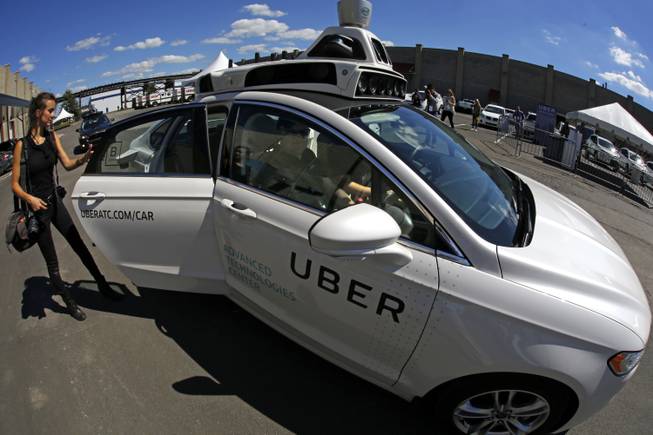
Gene J. Puskar / AP
A journalist gets in a self-driving Uber for a ride during a media preview at Uber’s Advanced Technologies Center in Pittsburgh Monday, Sept. 12, 2016.
Sunday, Oct. 30, 2016 | 2 a.m.
A photograph shows a lone automobile among dozens of horse-drawn buggies on Manhattan’s famed Fifth Avenue in 1900. Thirteen years later, another photo depicts the same thoroughfare clogged with gas-guzzling vehicles.
The images illustrate how quickly transportation innovations can take hold in society, a mobility-minded futurist recently told Southern Nevada leaders. His name is Paul Godsmark, and he’s co-founder of the Canadian Automated Vehicles Centre of Excellence.
Godsmark’s message: Autonomous vehicles could be the biggest thing to disrupt society since the internet.
“Change is going to happen really, really quick,” he said.
He’s not the only one predicting major shifts in the transportation industry. Anthony Foxx, secretary of the U.S. Department of Transportation, said autonomous vehicles would be traversing American roadways within five years. And in September, President Barack Obama penned an op-ed for the Pittsburgh Post-Gazette addressing this new wave of technology that he said had “the potential to transform the way we live.”
Godsmark envisions automated vehicles carrying people of all ages and backgrounds to their destinations with the tap of a smartphone app. Some cars may offer private cabins for riders; others may celebrate carpooling by grouping passengers with similar interests, he said.
Other automated vehicles will focus on delivering freight or small, custom deliverables. (Picture sidewalk-friendly vehicles carrying your pepperoni pizza.)
“The technology is coming like a freight train,” Godsmark said.
Ride-hailing giants have taken notice. Uber and Lyft have set their sights on eliminating human drivers within a few years. Their quest follows the theory that this rapidly evolving technology may render private car ownership a thing of the past.
The burgeoning, so-called “transportation as a service” industry also could disrupt public-transit systems. And for Tina Quigley, who heads the Regional Transportation Commission and organized a community event in which Godsmark offered his glimpse into the future, it’s enough to make her dust off her resume, she joked.
Quigley coordinated the event so Southern Nevada could prepare for whatever transportation realities may soon surface. After all, change already is apparent: RTC bus ridership is down roughly 4 percent compared with this time last year. The decline coincides with the introduction of ride-hailing companies in Southern Nevada.
“Those are hard things to hear,” Quigley said after Godsmark’s presentation. “Our role is to always make sure there are mobility options and convenient ways for people to get around. Recognizing that may mean we step back in some areas is a culture shift.”
The two transportation experts don’t necessarily agree on everything. Because of emerging technology, Godsmark said he didn’t see the point of installing light rail unless a city’s population was exploding. Quigley, who has advocated for light rail in Southern Nevada, still thinks it’s a viable option in dense, urban areas.
“The amount of geographical space that we have to move people is tight,” she said. “We need to be able to move large amounts of people.”
Automated-vehicle technology also poses a host of pros and cons. On the plus side, Godsmark said it could make travel safer, reduce noise and emissions, provide easier transportation for people without licenses and free up land devoted to parking. On the other hand, it could displace jobs and create privacy issues, he said.
In any case, Godsmark said federal and local governments should address the technology in transit plans and begin crafting policies and regulations.
That’s exactly what the RTC intends to do, Quigley said. The Transportation Resource Advisory Committee — a group of 36 stakeholders looking at funding options and helping prioritize projects — will develop transit plans for Southern Nevada. Godsmark’s presentation provides food for thought going forward, Quigley said.
“Before we launch too seriously into a transit conversation, let’s take a look at what’s going on in the world to make sure we ... do not invest in technologies that will be outdated,” Quigley said. “We are stewards of taxpayer dollars.”
Plus, Las Vegas could be at the forefront of this technological revolution. Autonomous vehicles already have been tested in Nevada, and officials say more likely will follow suit.
“I think being on the cutting edge of this is critical for Nevada,” said Steve Hill, the state’s chief economic officer.

Join the Discussion:
Check this out for a full explanation of our conversion to the LiveFyre commenting system and instructions on how to sign up for an account.
Full comments policy